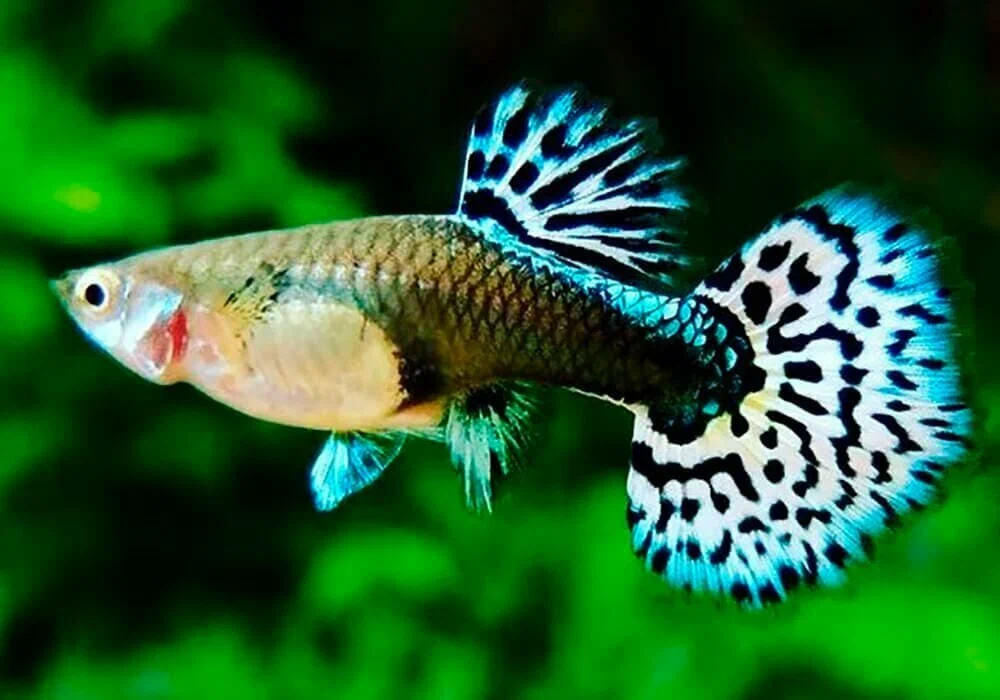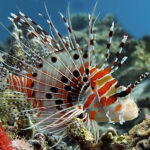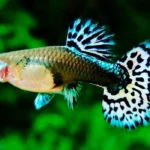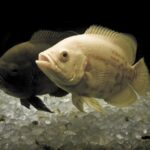Why Everyone Loves Guppy
Guppies The guppy (Poecilia reticulata) is one of the most beloved freshwater aquarium fish in the world. For experienced aquarists, they are often a hobby project and the first fish they keep.
Known as “rainbow fish” for their colors and “million fish” for their rapid reproduction. Native to South America but now found worldwide in tanks and natural waters. Guppies offer personality, color, activity, and ease of care in a small package.

A Little History: Origins of the Guppy
First discovered in the 1860s in Trinidad by Robert John Lechmere Guppy.
Scientific name: Poecilia reticulata, named for their net-like pattern.
They quickly became popular in science and the aquarium trade due to their rapid breeding.
Used in mosquito control because they eat larvae, especially in tropical regions.
Through selective breeding, dozens of strains have emerged with fancy tails and wild colors.
Guppy Appearance: A Living Rainbow
Males are smaller (1.5 inches) but brightly colored with elaborate fins.
Females are larger (up to 2.5 inches), normally more subdued in color, but still beautiful.
Blues and reds in neon colors to greens, purples, yellow, and metallic sheens.
Tail shapes include:
Fantail
Swordtail
Delta tail
Lyretail
Round tail
Some guppies have patterns such as snakeskin, mosaic, leopard, or tuxedo.
Every guppy is different, making them exciting to observe.
Personality and Behavior
Males display courtship dances—flaring fins and showing off. They’re curious and intelligent and often recognize their owners. Can be nippy toward slow or long-finned tank mates if bored or overcrowded. Thrive in a calm, well-planted community aquarium.
Guppies are calm, social fish that like to school together. They’re active swimmers, often exploring all levels of the tank.
Tank Setup: Giving Guppya Great Home
Tank Size
Minimum of 10 gallons for a small group.
Ideally, 20+ gallons to allow for swimming and future fry.
Bigger tanks offer more stable water parameters and less maintenance.
Water Parameters
Hardness: 8–12 dGH is best.
Use a heater and thermometer to stabilise the temperature.
Weekly water testing is crucial for health.
Filtration and Aeration
A gentle sponge filter or hang-on-back filter works well.
Guppy don’t like strong currents.
Aeration via air stones or filter flow ensures oxygenation.
Plants and Decor
Live plants like Java moss, hornwort, or anubias provide hiding spots and breeding cover.
Add caves or driftwood for aesthetics and comfort.
Substrate can be gravel, sand, or bare-bottom, depending on your goals.
Diet: Feeding Your Guppies Right
Omnivorous Diet
Guppy eat both animal- and plant-based foods.
Variety is key to color, health, and reproduction.
Staple Foods
High-quality flake food or micro pellets.
It should be protein-rich and designed for tropical fish.
Protein Supplements
Live or frozen options are great for excitement and nutrition.
Vegetables and Algae
Blanched spinach, peas, or spirulina flakes.
Some guppies nibble on algae in the tank.
Feeding Schedule
Feed 2–3 small meals per day.
Only offer what they can consume in 1–2 minutes.
Remove uneaten food to avoid water pollution.

Tank Mates: Who Can Live with Guppies?
Peaceful Companions
Tetras (neon, ember, cardinal)
Corydoras catfish
Harlequin rasboras
Mollies and platies
Snails (mystery, nerite)
Shrimp (ghost or cherry—though guppy fry might eat babies)
Tank Mates to Avoid
Aggressive fish (cichlids, bettas, barbs)
Fin-nippers
Very large fish that might see guppies as food
Guppy Breeding: The Baby Boom
Livebearers
Guppies don’t lay eggs—they give birth to live fry.
Females can store sperm and give birth multiple times after one mating.
Gestation lasts 21–30 days, depending on temperature and age.
How to Identify Pregnant Females
A gravid spot near the tail darkens as pregnancy progresses.
The belly becomes noticeably round and boxy.
Birth and Frying Care
Drop typically ranges from 20 to 50 fry.
Use a breeding box or separate nursery tank for fry survival.
Adults (even parents) may eat newborn fry—hiding spaces are crucial.
Fried Food
Crushed flake, baby brine shrimp, or specialized fry food.
Feed small amounts several times a day for rapid growth.
Health and Common Issues
Lifespan
Average 2–3 years with good care.
Proper diet, clean water, and low stress prolong life.
Signs of Good Health
Active swimming, bright eyes, colorful body, healthy fins.
Eagerness to eat and engage with tank mates.
Common Diseases
Ich—White spots; treat with heat and medication.
Fin rot—Frayed fins, often due to poor water.
Dropsy—swollen—swollen body; hard to treat, often fatal.
Swim bladder issues—Fish floats or sinks oddly, linked to overfeeding or infection.
Quarantine new fish to avoid disease spread.
Fun Guppy Facts
Guppies can change color slightly depending on their mood or environment.
Females prefer colorful males in mating displays.
Some guppies can live in brackish or even slightly salty water.
Seasonal and Environmental Considerations
Keep the temperature stable during winter with a reliable heater.
During summer, avoid overheating—use fans or lower room temperatures.
Use a timer for consistent light cycles—8 to 12 hours per day.

Advanced Guppy Keeping: For Enthusiasts
Show Guppies
Competitive guppy showing is a global hobby.
Judged based on symmetry, tail spread, coloration, and rarity.
Requires selective breeding, controlled environments, and genetic tracking.
Guppy Colonies
Some aquarists prefer a self-sustaining guppy colony.
Managed population with minimal interference.
Provides natural selection and educational value.
Troubleshooting: When Things Go Wrong
My Guppies Keep Dying
Check water parameters: ammonia, nitrites, and nitrates.
Overfeeding, poor tank mates, or contaminated water are likely causes.
Males Keep Harassing Females
Add more females (ratio 2–3 females per male).
Provide hiding spots and plants.
Use tank dividers if necessary.
My Guppies Lost Color
Stress, poor diet, or lack of lighting can dull colors.
Improve nutrition and reduce tank stressors.
Budgeting for Guppies
Initial setup (tank, filter, heater, décor): $100–200
Fish: $3–10 each (fancy strains may cost more)
Food and supplies: $10–20/month
Guppies are affordable, especially compared to marine or exotic species.
Guppies and Kids: A Great Starter Pet
Low maintenance makes them ideal for teaching responsibility.
Visual appeal keeps children interested and engaged.
Easy to breed and care for—with adult supervision.
Final Thoughts: Why Guppies Are the Heart of Home Aquariums
Guppies offer everything: beauty, activity, ease of care, and the joy of life cycles.
Whether you’re a beginner with a desktop tank or an expert breeder chasing rare strains, guppies never disappoint.
With proper care, they can become the sparkling centerpiece of your aquatic world.

Conclusion
Guppies offer everything: beauty, activity, ease of care, and the joy of life cycles.
Whether you’re a beginner with a desktop tank or an expert breeder chasing rare strains, guppies never disappoint.
With proper care, they can become the sparkling centrepiece of your aquatic world.
Guppies have long held a special place in the hearts of fish keepers all over the world, which is easy to see why.
FAQs
Are guppies good for beginners?
Absolutely! Guppies are one of the best fish for beginners due to their durability, ease of care, and tolerance for minor errors. Because they don’t require a lot of upkeep or fancy equipment, they’re perfect for people just starting out in the aquarium hobby.
How long do guppies live?
Guppies typically live for two to three years with good care. They can reach the upper end of that range—or even stay there for longer—with clean water, a well-balanced diet, and less stress.
Will guppies breed in my tank?
Yes, they will almost certainly! Because they are livebearers, guppies are easy to breed in community tanks. Females may even store sperm to produce multiple broods and can give birth every 30 days. Keep only males or take steps to separate the sexes if you don’t want children.
Can guppies live with other fish?
Guppies, like mollies, platies, tetras, and corydoras, are non-aggressive community fish that can coexist peacefully with them. Keep them away from fin-nippers and other aggressive fish like tiger barbs and larger cichlids.
How often should I feed my guppies?
Guppies can consume a small amount of food in about a minute if fed once or twice a day. Since overfeeding is a common problem, it’s better to slightly underfeed than to overfeed.










